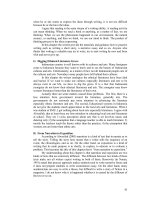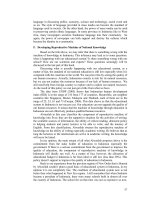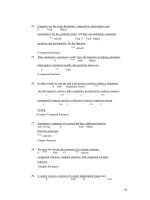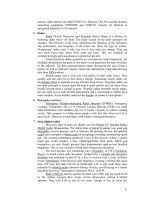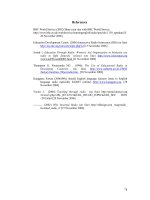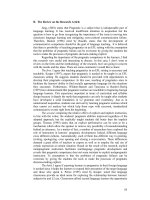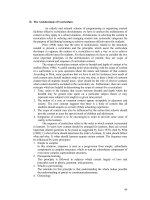TEACHING AND LEARNING pedagogy, curriculum and culture by alex moore
Bạn đang xem bản rút gọn của tài liệu. Xem và tải ngay bản đầy đủ của tài liệu tại đây (873.36 KB, 209 trang )
Teaching and
Learning
Teaching and Learning: Pedagogy, Curriculum and Culture provides an
overview of the key issues and dominant theories of teaching and learning as
they impact upon the practice of classroom teachers. Punctuated by questions,
points for consideration and ideas for further reading and research, the book’s
intention is to stimulate discussion and analysis, to support understanding of
classroom interactions and to contribute to improved practice.
Topics covered include:
•
•
•
•
•
an assessment of dominant theories of learning and teaching;
the ways in which public educational policy impinges on local practice;
the nature and role of language and culture in formal educational
settings;
an assessment of different models of ‘good teaching’, including the
development of whole-school policies;
alternative models of curriculum and pedagogy
Alex Moore has taught in a number of inner-London secondary schools, and for
ten years lectured on the PCGE and MA programmes at Goldsmiths University
of London. He is currently a senior lecturer in Curriculum Studies at the
Institute of Education, London University. He has published widely on a range
of educational issues, including Teaching Multicultural Students: Culturism and
Anti-Culturism in School Classrooms published by RoutledgeFalmer.
Key Issues in Teaching and Learning
Series Editor: Alex Moore
Key Issues in Teaching and Learning is aimed at student teachers, teacher
trainers and inservice teachers including teachers on MA courses. Each book
focusses on the central issues around a particular topic supported by
examples of good practice with suggestions for further reading. These
accessible books will help students and teachers to explore and understand
critical issues in ways that are challenging, that invite reappraisals of
current practices and that provide appropriate links between theory and
practice.
Teaching and Learning: Pedagogy, Curriculum and Culture
Alex Moore
Reading Educational Research and Policy
David Scott
Understanding Assessment: Purposes, Perceptions, Practice
David Lambert and David Lines
Understanding Schools and Schooling
Clyde Chitty
Teaching and
Learning
Pedagogy, Curriculum and Culture
Alex Moore
London and New York
First published 2000 by RoutledgeFalmer
11 New Fetter Lane, London EC4P 4EE
Simultaneously published in the USA and Canada
by RoutledgeFalmer
29 West 35th Street, New York, NY 10001
This edition published in the Taylor & Francis e-Library, 2003.
RoutledgeFalmer is an imprint of the Taylor & Francis Group
© 2000 Alex Moore
All rights reserved. No part of this book may be reprinted or reproduced
or utilised in any form or by any electronic, mechanical, or other means,
now known or hereafter invented, including photocopying and recording,
or in any information storage or retrieval system, without permission in
writing from the publishers.
British Library Cataloguing in Publication Data
A catalogue record for this book is available from the British Library
Library of Congress Cataloging in Publication Data
A catalogue record for this book has been requested
ISBN 0-203-48755-9 Master e-book ISBN
ISBN 0-203-79579-2 (Adobe eReader Format)
ISBN 0-7507-1000-4 (Print Edition)
For Miranda, Jess, Ben and Jack
Contents
List of Figures
Acknowledgements
Series Editor’s Preface
viii
ix
xi
1
Models of Teaching and Learning
1
2
Teaching, Learning and Education
33
3
Teaching, Learning and Language
62
4
Teaching, Learning and Culture
91
5
Effective Practice: what makes a good teacher?
120
6
Working With and Against Official Policy:
pedagogic and curricular alternatives
149
References
Index
177
188
vii
Figures
1.1 ‘Mental ages’ and the ‘ZPD’
1.2 Possible pedagogic implications of ‘Piagetian’ and
‘Vygotskyan’ perspectives
2.1 Official rationales for formal state education
2.2 Articulations between purpose and theory of education
2.3 Possible unofficial official rationales for formal state education
2.4 Key aspects of Enlightenment thinking in the development
of state education
3.1 The ‘How many squares?’ problem
3.2 Ratio and proportion exercise
4.1 Modes of differentiation
5.1 The teacher as strategist
viii
17
21
35
37
50
52
68
69
108
141
Acknowledgements
My thanks to Val McGregor, Susan Sidgwick and Elizabeth Plackett, whose
advice and wisdom helped me greatly in the writing of Chapter 3: Teaching,
Learning and Language. Also to Gwyn Edwards for his invaluable help and
advice in preparing the sections on Reflective Practice and Action Research in
Chapter 5, and to Ron Greer and the staff at Acton High School for allowing
me to use their Teaching and Learning policy document to exemplify points on
whole-school policies in the same chapter.
ix
Series Editor’s Preface
THE KEY ISSUES IN TEACHING AND LEARNING SERIES
Teaching and Learning is one of five titles in the series Key Issues in Teaching
and Learning, each written by an acknowledged expert or experts in their field.
Other volumes explore issues of Understanding Assessment, Understanding
Schools and Schooling, and Reading Educational Research and Policy. The
books are intended primarily for beginner and newly or recently qualified
teachers, but will also be of interest to more experienced teachers attending MA
or Professional Development Courses or simply interested in revisiting issues of
theory and practice within an ever-changing educational context.
TEACHING AND THEORISING
There is currently no shortage of books about teaching, offering what must
sometimes seem a bewildering choice. Many of these books fall into the ‘howto’ category, offering practical tips and advice for teachers on a range of
matters such as planning for students’ learning, managing classroom behaviour,
and marking and assessing students’ work. Such books have proved very
successful over the years, providing beginner-teachers in particular with much
of the support and reassurance they need to help them through their early
experiences of classroom life, as well as offering useful advice on how to make
teaching maximally effective. Increasingly, such books focus on sets of teacher
competences—more recently linked to sets of standards—laid down, in the UK,
by the Office for Standards in Education (OFSTED) and the Teacher Training
Agency (TTA) (see, for instance, OFSTED and TTA 1996). Other books have
focused on the teacher’s need to be reflective and reflexive (e.g. Schon 1983;
1987; Valli 1992; Elliott 1993; Loughran 1996). These books may still be
described as ‘advice books’, but the advice is of a different kind, tending to
encourage the teacher to think more about human relationships in the
teaching—learning situation and on the ways in which teaching styles connect
to models of learning and learning development.
More predominantly theoretical books about teaching for teachers are perhaps
in shorter supply, and those that do exist often address issues in decontextualised
xi
xii
SERIES EDITOR’S PREFACE
ways or in very general terms that do not immediately speak to classroom
practitioners or take account of their particular academic backgrounds. There is,
furthermore, evidence that, partly through time constraints, some of the most
profound works on sociological educational theory, by such commentators as
Bourdieu, Foucault and Bernstein, are very little read or discussed on teacher
training courses (Moore and Edwards 2000), while the work of developmental
psychologists such as Piaget and Vygotsky, which used to feature very prominently
on PGCE and BAEd courses, has become increasingly marginalised through a
growing emphasis on issues of practical discipline, lesson planning, and meeting
National Curriculum requirements.
Teaching and Learning: Pedagogy, Curriculum and Culture, like the other
books in this series, seeks to address this imbalance by exploring with teachers a
wide range of relevant educational theory, rooting this in classroom experience in
a way that encourages interrogation and debate, and presenting it in a language
that is immediately accessible. The book does not ignore or seek to devalue
current trends in educational practice and policy, or the current dominant discourses
of competence and reflection (indeed, it is constructed very much with the OFSTED/
TTA sets of competences and standards in mind). Rather, it aims to provide
readers with the knowledge and skills they will need in order to address and
respond to these and other educational discourses in critical, well-informed ways
that will enhance both their teaching and their job satisfaction.
With this aim in mind, the book does not tell readers how they should teach;
nor does it seek to cram prepackaged, ready-made theory down readers’
throats. Instead, it seeks to present issues, questions and dilemmas about
teaching and learning processes—and curriculum practices—to which it invites
teachers to formulate their own responses through guided activities, through
discussion with colleagues, through further reading, and, most importantly,
through refining their own educational theory in terms of what articulates best
with or most effectively challenges their existing philosophies and classroom
practice. In doing this, the book seeks to provide a philosophical and
theoretical context for teachers’ developing classroom practice, and to help
empower teachers to participate fully in local and national debates about the
nature, the purposes and the future of compulsory education both in the UK
and elsewhere.
Because of its brief, Teaching and Learning makes no claim to cover
everything that needs to be covered on its given subject. Rather, it is presented
as an individual account that makes moderately detailed selections from
current theory, basing those selections on what has proved most useful to the
author in his own professional practice and what, in his judgement, will provide
the most useful entry-points to other teachers for practical and theoretical
interrogations of their practice. In this respect, the book is intended not as a
competitor or as an alternative to ‘how-to’ books, or indeed to books that
explore specific issues in far greater depth (I am thinking, for example, of David
Wood’s excellent How Children Think and Learn [1988], which explores, in far
greater depth than I have been able to, a range of different models of learning).
SERIES EDITOR’S PREFACE
xiii
It is more appropriately viewed, like the other volumes in the series, as a
different—and complementary—kind of text: one that takes, as its startingpoint, a view that in order to be effective practitioners, and to be able to
continue to develop as effective practitioners, teachers need a grounding in
some of the key theories and issues within which their practice is sited, and need
to have a genuine, critical interest in those theories and issues.
Teaching and Learning does not, either, set out to consider all aspects of
teaching and learning. Because its primary focus is on teaching and learning
related to cognitive—linguistic and (to a lesser degree) affective development
(what might, taken together, be termed ‘academic development’), it does not
have a great deal to say about the teaching and learning of interpersonal skills,
or of the development of what is sometimes referred to as ‘social intelligence’,
or of the implications for teaching and learning of students’ and teachers’
feelings—including their feelings about what is being learned and taught. This
is not because I believe these other areas of learning to be unimportant, or to
have nothing to do with teachers or schools. (Indeed, a belief that learning has
a primarily social function as well as a primarily social nature [Nixon et al.
1996] underpins everything else that is argued within the book.) Nor does it
imply that such issues are not relevant to cognitive-linguistic-affective
development. The importance of interpersonal relationships is central, for
example, to the work of Vygotsky (1962; 1978) and Bruner (1996), explored
in some depth in Chapter 1, while the need for teachers to take account of the
emotional context of the classroom—and indeed the part played by the
emotions in academic learning—is becoming increasingly recognised (e.g.
Britton 1969; Appel 1995; Boler 1999). If Teaching and Learning has little to
say about these important matters, it is hoped that readers will see this as a
pragmatic choice, related to what is manageable within the covers of one
volume, rather than as a deliberate marginalisation.
STRUCTURE AND CONTENT OF THE BOOK
Teaching and Learning is presented as six chapters, each of which has a degree
of integrity that enables it to be read independently of the other chapters—
although deliberate echoes and elaborations of points made in earlier chapters
have been included in those that follow. Each chapter starts with a summary,
and concludes with suggestions for further reading and areas for thinking and
research. While the readings and activities can be undertaken independently,
they are designed so that they can also be completed collaboratively, providing
the basis for small-group discussions on BAEd, PGCE, MA and Professional
Development courses for teachers. As with other volumes in the Key Issues in
Teaching and Learning series, boxes have been used in the body of the text to
highlight particularly important points or useful summaries.
The book begins with a chapter on Models of Teaching and Learning, which
offers an overview of some of the more influential theories of cognitivelinguistic theory to have emerged this century. The particular focus here is on
xiv
SERIES EDITOR’S PREFACE
some of the work of Piaget, Vygotsky and Bruner, and includes an assessment
of the similarities and key differences between these thinkers’ theories as well
as of the implications for teaching.
With reference to historical documents, Chapter 2, Teaching, Learning and
Education, explores some of the official purposes of formal education, and
invites readers to consider the extent to which these purposes and associated
policies articulate or fail to articulate with the theories of development
described in Chapter 1, or indeed with their own favoured models and theories
of learning and teaching.
Chapter 3, Teaching, Learning and Language, examines the role and significance
of teacher and student language in teaching and learning, and in particular the
ways in which language can help or hinder learning depending on how it is used.
Chapter 4, Teaching, Learning and Culture, develops many of the issues
raised in Chapter 3, examining, with the support of classroom-based case-study
material, the ways in which cultural bias can operate against the interests of
some students and to the benefit of others. It begins to consider some of the
approaches teachers might take to counterbalance such systemic cultural bias.
In Chapter 5, Effective Practice: What makes a Good Teacher?, the emphasis
of the book shifts away from student development and systemic bias towards
pedagogy—exploring, and inviting readers to critique, some currently dominant
theories and models of ‘good teaching’ and ‘effective practice’. This includes
considerations of the ways in which teachers need to be ‘competent’ as well as
being reflective, reflexive, strategic and in possession of good communication
skills. The notion of the whole-school policy is also discussed within the context
of its ability to support teachers in their pedagogic development and to provide
an ‘action space’ within which teachers can continue to reflect on and debate their
own and their school’s classroom practice.
The book’s final chapter, Working With and Against Official Policy, revisits
some of the issues raised in Chapter 2: How do teachers handle discrepancies
between their own teaching philosophies and practice and those promoted by
Government policy? To what extent and in what fashion do pedagogical
compromises have to be made because of characteristics of the larger social and
educational systems, or because the ‘reality’ of the classroom militates against
the pursuit of preferred practices and goals? What ‘action’ spaces can teachers
find within current bureaucratic and curricular arrangements to promote forms
of practice and curriculum content that they feel are under threat? These issues
are explored within the context of ‘alternative’ models of curriculum and
pedagogy—including notions of ‘accelerated learning’ and ‘multiple
intelligences’—currently being promoted by a range of experts in a variety of
fields. Readers are encouraged to consider the ways in which not only
curriculum content and style but also their own practice as teachers might
usefully develop in the changing social and natural world in which they live.
Whereas Chapter 2 principally looked back, to the policies and decisions that
have shaped and that continue to constrain curriculum and classroom practice,
Chapter 6 looks forward, to more recent ideas about teaching and learning that
may have greater relevance to students and societies in the twenty-first century.
SERIES EDITOR’S PREFACE
xv
REFERENCES
Appel, S. (1995) ‘The Unconscious Subject of Education.’ Discourse 16(2),
167–190
Boler, M. (1999) Feeling Power: Emotions and Education. New York and
London: Routledge
Britton, J. (1969) ‘Talking To Learn.’ In Barnes, D., Britton, J. and Torbe, M.
Language, the Learner and the School. Harmondsworth: Penguin
Bruner, J. (1996) The Culture of Education. Cambridge, Mass: Harvard
University Press
Elliott, J. (1993) ‘The relationship between “understanding” and “developing”
teachers’ thinking.’ In Elliott, J. (ed.) Reconstructing Teacher Education.
London: Falmer Press
Goleman, D. (1996) Emotional Intelligence. London: Bloomsbury
Loughran, J. (1996) Developing Reflective Practice: Learning About Teaching
and Learning Through Modelling. London: Falmer Press
Moore, A. and Edwards, G. (2000) ‘Compliance, Resistance and Pragmatism
in Pedagogic Identities.’ Paper presented at the Annual Conference of the
American Educational Research Association, New Orleans, 24–28 April
2000
Nixon, J., Martin, J., McKeown, P. and Ranson, S. (1996) Encouraging
Learning: Towards a Theory of the Learning School. Buckingham and
Philadelphia: Open University Press
OFSTED/TTA (Office for Standards in Education/Teacher Training Agency)
(1996) Framework for the Assessment of Quality and Standards in Initial
Teacher Training 1996/97. London: OFSTED
Schon, D.A. (1983) The Reflective Practitioner: How the Professionals Think
in Action. New York: Basic Books
Schon, D.A. (1987) Educating the Reflective Practitioner. San Francisco:
Jossey-Bass
Valli, L. (ed.) (1992) Reflective Teacher Education. New York: State University
of New York Press
Vygotsky, L.S. (1962) Thought and Language. Cambridge, Mass.: M.I.T. Press
Vygotsky, L.S. (1978) Mind in Society. Cambridge, Mass.: Harvard University
Press
Wood, D. (1988) How Children Think and Learn. Oxford: Blackwell
1
Models of Teaching
and Learning
This chapter introduces some of the most influential theories of learning and
development of recent years. These theories have been used both to support
early models of school instruction and to initiate and develop new ones,
including models that have come to be labelled ‘progressive’, ‘constructivist’
and ‘child-centred’. With an initial emphasis on learning rather than teaching,
the chapter gives particular emphasis to the complementary developmental
theories of Piaget and Vygotsky, foregrounding Vygotsky’s sustained
argument that all learning is essentially social in nature. Detailed reference
is also made to the work of Skinner and Bruner and to the implications of
their theories for classroom practice and experience. As the classroom
implications of Piaget’s and Vygotsky’s work are explored, the emphasis of
the chapter shifts from learning to teaching. The work of both theorists is
considered within the context of National Curricula and current debates
about educational priorities and styles of teaching and learning.
THEORIES OF LEARNING AND TEACHING
Every schoolteacher operates according to a theory or theories of learning and
within the context of a philosophy of what education should be fundamentally
about. The only difference is that sometimes these theories are very consciously
held and operated upon by the teacher, perhaps carefully referenced to
published theory in the field, while others are held and operated upon rather
less consciously, with perhaps little or no reference to published theory.
The central purpose in this first chapter is to consider some of the major
published theories of learning and teaching practice that have emerged over the
last seventy years or so, and to assess the extent to which these are supported
by—or lend support to—(a) central government policy (as manifested, for
example, in the National Curriculum), (b) teachers themselves, operating
within the terms of their own privately and professionally held views and
beliefs as to what constitutes a good education and what effective teaching and
learning look like. Of particular interest will be the extent to which the
favoured models of teaching and learning espoused by teachers chime or fail to
1
2
MODELS OF TEACHING AND LEARNING
chime with the models advocated explicitly or implicitly in government policy.
This theme will be explored in greater detail in the following chapter, when we
consider the extent to which favoured models of teaching and learning (both
teachers’ and governments’) articulate with ‘official’ and ‘unofficial’ notions of
what formal education itself is fundamentally there for. It is hoped that the
revisiting of published theory will support teachers in articulating and
interrogating their own theory and practice in the social and educational
contexts within which they currently operate.
To do full justice to the range of learning theories at teachers’ disposal and to
the similarities and differences between them is an undertaking immense in its
scope. To illustrate this point, we need only allude to the numerous books that
have been written by and about one of the major educational theorists of the
present century, Jean Piaget. What I shall seek to accomplish in this chapter is
not to attempt to provide the reader with a comprehensive tour of current and
past educational thinking, but to select a number of relatively recent theorists
whose work I consider to be of particular importance or relevance. I shall
provide no more than an outline of what I take to be some of the key ideas of
these theorists, inviting the reader to explore their work in more detail in
whatever way seems most appropriate. In this respect, readers are strongly
recommended to go back to original sources: in the end, difficult though some
of this reading is, there is no substitute for gaining first-hand experience of the
work of such writers as Piaget, Vygotsky and Bruner, and of making personal
sense of that work in the context of one’s own classroom experience. Readers are
also recommended to explore texts which deal with aspects of teaching and
learning that are specifically not included in this chapter—not because I consider
them unimportant, but because the breadth of scope of the book has demanded
a high degree of selectivity. Jessel, for example (1999), provides a particularly
useful and cogent account of the relationship between learning and study,
referencing this to much of the cognitive theory drawn upon in this chapter.
WHICH THEORIES?
In deciding what makes a theorist ‘particularly important or relevant’, I had
initially intended to select those writers whose work appeared to have been
most influential in contributing to, supporting or even determining public
policy on education. This has remained a central criterion. However, as we shall
see in Chapter 2, the presence of explicit theory related to the processes of
teaching and learning in public policy documents has been generally
conspicuous by its absence. Consequently, I have had to make my own
judgements as to what elements of whose theories appear to sit most
comfortably with official government policy. I am also aware that recent
research (e.g. Halpin, Moore et al. 1999–2001) suggests that teachers
themselves often have surprisingly little explicit knowledge of the ideas of
theorists of teaching and learning, being much more concerned with ‘the
realities and actualities of classroom experience’. With these reservations in
MODELS OF TEACHING AND LEARNING
3
mind, I have used my own judgement and experience to select those theorists
whose work seems to:
•
•
•
be most obviously embedded in teachers’ everyday classroom practice
and teaching philosophy (even though it may not be identified and
articulated by teachers);
support or be supported by the various dominant discourses in teaching
and learning (for example, the ‘levels’ approach of the National
Curriculum in the UK, or the group-work approach still favoured by
many classroom teachers);
offer the best routes into the exploration of a range of key issues and
debates in the field (for instance, the ‘student-centred’/‘teacher-led’
debate).
I have avoided theories and theorists—often more recent—where I have judged
that there is insufficient evidence on which to base realistic evaluations of them.
These include recent work on accelerated learning and multiple intelligences—
although I shall return to each of these in the final chapter, when we consider
‘alternative’ pedagogies and curricula.
While reference to key educational theorists may be absent from much
official documentation, there is no doubt that their work has contributed—
selectively and even locally, perhaps—to the educational zeitgeist, and that,
although their work cannot claim to predate the teaching philosophies and
classroom practice with which it is typically associated (Piaget’s work with
‘child-centredness’, for example, or Vygotsky’s with dialogic teacher-student
relationships) it has often lent credence and implicit support to official policy,
to government-commissioned reports and surveys, and to teachers’ own
philosophies and practice. It has also informed—and continues to inform—
courses of and textbooks for initial and continuing teacher education (see, for
example, Scott Baumann et al. 1997).
THEORY AND THE EDUCATIONAL CONTEXT
Most of the theories of language and learning that we shall be considering in
this chapter can be described as essentially psychological in character: that is
to say, they focus on the nature and development of the ‘individual mind’ in so
far as it may conform to or deviate from certain identifiable and recognisable
‘universal patterns’ of development. Partly because of this, much of it has arisen
from experimental research carried out with children (typically, with very
young children rather than, say, adolescents) removed from the familiar social
contexts within which they would normally be operating. One consequence of
this is that much of the theory tends to overlook what we might call the
contingent and idiosyncratic aspects of teaching and learning: that is to say,
aspects related to particular school or individual circumstances, to cultural
preferences and biases, to the ongoing role of parents in the developmental
4
MODELS OF TEACHING AND LEARNING
process, or to the philosophies, policies and ideologies within and upon which
education is constructed. (As we shall see, some of Vygotsky’s and some of
Bruner’s work—especially Bruner’s more recent work—provides notable
exceptions to this rule.)
A particular difficulty with experimental work of this nature, conducted
outside the normal context in which human development occurs (Piaget, for
example, did not base his theories on longitudinal observations of children in
their homes or their classrooms but on tasks conducted by them under
‘experimental conditions’) is that it may produce results that are not typically
repeated in those normal contexts—a problem exacerbated by the fact that the
person carrying out or supervising the experiments may not be accustomed to
working with children in everyday social situations and may not have been
trained to do so. Margaret Donaldson (1978), as we shall see, has thus cast
doubt on some aspects of Piaget’s theories by repeating some of his experiments
in more ‘natural’ situations and by using more ‘normal’ language with which
the children are familiar and comfortable.
LEARNING AND BEHAVIOUR: SKINNER’S LAW OF
‘POSITIVE REINFORCEMENT’
One theorist whose work continues to reflect not just the ways in which schools
and teachers behave towards students but also a growing commonsense view
of how development in general (i.e. both inside and outside the school setting)
occurs and should be managed is Burrhus Frederic Skinner (1953). Much of
Skinner’s theory revolves around the view that people learn best by being
rewarded for ‘right responses’ or by responses that show evidence of having the
potential eventually to lead to ‘right responses’ (sometimes known as ‘operant
conditioning’). Starting with Thorndike’s ‘law of positive effect’, Skinner
elaborates what he calls the ‘law of positive reinforcement’, which includes the
notion that school-students can be trained to replicate certain (adult)
behaviours if they come to associate such replication with the occasional (and
therefore possible) receipt of tangible rewards. These days, such rewards might
include ‘merit marks’, various forms of public approval, special privileges, and
even sweets.
Skinner’s theory emphasises not only the importance of a high level of
positive reinforcement in the classroom, but also the use of highly structured
materials through which students can work step by step towards externally
imposed goals. Because the making of mistakes is thought by Skinner to
demoralise or demotivate the learner, interfering with their steady progress, he
advocates that such materials should, as far as possible, be ‘error free’ . Very
structured, ‘scripted’ lessons, with teachers’ words pre-ordained and seldom
significantly deviated from, are linked to a very fixed—sometimes loosely
referred to as a ‘traditional’—discursive pattern of ‘Teacher initiates (through,
for example, asking a scripted question or providing a simple instruction),
student responds’.
MODELS OF TEACHING AND LEARNING
5
Skinner’s work—which belongs to a much wider body of work growing out
of behavioural theories of learning (for a much fuller account of these, see
Bower and Hilgard 1981)—has undoubtedly left its mark in the areas of
working with students with learning difficulties (Scott Baumann et al. 1997, p.
49) and, in particular, of managing classroom behaviour. In this latter respect,
aspects of Skinnerean theory have become an integral and unquestioned part of
much of what is now known as ‘progressive’ classroom practice. We might
point, for example, to the practice of rewarding students for ‘appropriate’
behaviour rather than endlessly and futilely punishing them for ‘inappropriate’
behaviour, or the ‘Skinnerean’ notion that before deciding on a programme of
instruction for any student the teacher needs to establish, as a baseline, what
the student already knows and can do.
Such common practices as establishing groundrules for behaviour, setting targets,
privileging praise, providing meaningful rewards, being clear and open with students
about what is unacceptable behaviour and what rewards will consistently follow
good behaviour, and the avoidance of unhelpfully vague diagnostic phrases such
as ‘disruptive’ or ‘disturbed’, may all be seen as sitting comfortably with Skinnerean
theory. The theory may also be seen to support an increasingly common practice in
schools of establishing a ‘rights and responsibilities’ policy, whereby students may
‘earn’ shorter long-term privileges through periods of sustained good behaviour or
academic progress.
If Skinner’s theory has become regularly applied to the ‘pastoral’ and
‘behavioural’ aspects of teaching and learning, its relation to cognitiveacademic learning and development and to issues of pedagogy has generally
proved too simplistic to be of enduring value, reminding us that much of the
theory was derived in the first instance from experiments with animals. (For a
more detailed account of Skinner’s behaviourist theory, related to the work of
Pavlov, see Wood 1988.) In recent times, many of Skinner’s ideas have been
overtaken by subtler theories of development, that have emphasised the social,
interactive nature of learning (see, for example, Vygotsky 1962, 1978) and the
need for students to ‘construct’ knowledge through experience rather than
merely to ‘receive’ it (that is to say, a ‘constructivist’ approach to learning and
teaching: see also Jessel 1999).
Particular difficulties in relating Skinnerean theory to academic-cognitive
development and behaviour include:
•
•
the development of a widely held view that making errors and taking
risks represent an important and fundamental part of learning (Skinner,
by contrast, seeks to reduce risk);
an increasing rejection of school-learning as being principally contentbased, and a corresponding privileging of learning processes (the
Skinnerean approach may be seen to reduce questions of process to a
simple matter of conditioning);
6
MODELS OF TEACHING AND LEARNING
•
•
•
•
an increasing interest in the ‘invisible’, ‘unreachable’ aspects of
learning and progress, to set alongside the more readily observable
ones (as we shall see, students are quite capable of getting ‘right
answers’ without having an adequate grasp of the concepts involved,
while ‘wrong’ answers may often mask the hidden development of
‘right’ processes);
an understanding that concepts actually develop rather than remaining
the same (there is no real space in Skinner’s theory for the notion of
concept development: answers are generally treated as right or wrong,
and knowledge as crystallised and finite);
an increasing understanding that learning is an active, creative business
rather than an essentially receptive one;
a fear that if students work to externally-conferred ‘rewards’, rather
than becoming independent learners who see learning itself as
intrinsically rewarding, they may lose the motivation to learn once the
source of the rewards is no longer there (the issue of motivation will
be returned to later in this chapter).
Even in the area of managing students’ behaviour, Skinner’s theory is not
without its difficulties, especially in the multicultured classrooms in which
many teachers nowadays operate. Specifically, Skinner’s work may be criticised
as overlooking cultural issues related to behaviour, and the fact that a
consistently applied set of punishments and rewards may prove inflexible and
counterproductive in many classroom situations. (With reference to this point,
readers are invited to consider the case, reported in Moore 1995 and elsewhere,
of the bilingual student who respectfully averts his eyes from the teacher when
being chastised, only to be doubly chastised for what is interpreted by the
teacher as a gesture of rudeness or defiance. Examples of how bilingual
students often fail to invoke teachers’ rewards for the effort they put into their
academic work because it is interpreted as wrong rather than simply different
can be found in Moore 1999a and are discussed in Chapter 4 below.)
Skinner’s theory may also be criticised for its underplaying of the role of
teachers’ own behaviours in the teaching and learning processes, tending to
limit its considerations in this area to matters of the awarding of punishments
and rewards rather than, say, the need for teachers to be reflective and
reflexive. It also offers little help to teachers who have to deal with students
who simply choose not to ‘play the behaviour game’ (see, too, Willis 1977):
students, that is, who appear not to care whether or not they succeed
academically or whether or not they are praised or chastised by the teacher. In
this respect, the theory has little to say about ‘internal’ motivation and personal
expectations or goals, and does not take full account of the extent to which an
unwillingness or an inability to conform to certain behaviours may be confused
with a cognitive deficiency in the student.
This latter difficulty may be seen as part of a more general concern over
Skinner’s work, that it does not sufficiently problematise the overlaps and
interactions between behaviour and achievement. The awarding of ‘pass
MODELS OF TEACHING AND LEARNING
7
grades’ in public examinations offers a graphic example of this kind of overlap
and resultant confusion. On the one hand, the awarding of a good exam grade
may be seen as merely representing a recognition or marker of the student’s
previous achievement. On the other hand, the grade may be seen as an ultimate
reward in itself for ‘doing the right thing’—a reward that can be cashed in for,
say, a university place or a prestigious job. In this respect, the exam grade may
itself be seen as the student’s achievement, rather than the effort and thought
that have gone into getting it.
JEAN PIAGET: ACTIVE LEARNING
An influential theorist whose work does continue to contribute very significantly to
debates about cognitive development is Jean Piaget. Unlike Skinner, whose theory
often seems to present the learner as malleable material on whom the teacher
must work, Piaget’s enduring legacy to educational theory is the assertion that
human beings are, from early childhood, active, independent meaning-makers who
construct knowledge rather than ‘receive’ it. We make connections with our physical
and social environments, to be sure, and are in some important senses controlled
by them; however, this is a fundamentally interactive process involving acts of what
Piaget describes as assimilation and accommodation.
•
•
‘Assimilation’ is the process by which the learner incorporates, as it
were, elements of the physical world into the logic of his or her own
developing and existing understandings or ‘interpretative categories’
(Barnes 1976, p. 22). A simple example of assimilation, observable in
very young children, is the incorporation of everyday household
objects such as slippers, hairbrushes or empty jars into play activity,
whereby those objects come to represent for the child some other thing
(a cave, a forest, a person, and so forth). People continue to ‘assimilate’
as they grow older. However, assimilation becomes increasingly
associated with our developing understandings of the world and the
ways in which we conduct ourselves in society. Too much assimilation,
and we may become rather ineffective learners, interpreting every new
event or piece of evidence in a way that leaves unchanged our initial,
very fixed view of the world and our sense of individual infallibility.
‘Accommodation’ refers to the process by which human beings adapt
their developing understandings and expectations to the realities and
constraints of the social and physical world in order to arrive at better
understandings or explanations. In this way, accommodation acts as a
kind of counterbalance or complement to assimilation. A central part
of the learning of young children, for example, concerns the
8
MODELS OF TEACHING AND LEARNING
development of understandings that if certain actions are attempted
(eating household objects, leaning forward into thin air, trying to turn
a light on by hitting it, and so on) they will inevitably result in failure
or pain (very often, the pain of parental chastisement!). Just as too
much assimilation produces inflexible, self-centred learners, we might
surmise that too much accommodation results in a very passive,
uncertain learner afraid to make explorations or to take risks.
Piaget suggests that effective human learners achieve a certain balance of
assimilation and accommodation in their interactions with the physical and
social environment, through a process of ‘equilibration’ (Piaget 1975, pp. 30ff).
To quote Douglas Barnes’ succinct summary of how this works: ‘By the
simultaneous action of assimilation and accommodation […] events are
perceived as meaningful and at the same time generate changes in the
interpretative procedures’ (Barnes 1976, p. 22). An important point here is that
assimilation and accommodation do not only enable us to make sense of the
world, but that sense-making itself contributes, each time, to the way we think
and perceive, and therefore to our capacity to make sense of future experience
and events. In Barnes’ words, ‘These changes are transformations not
additions’ (ibid., emphasis added).
Piaget’s suggestion that learning is an essentially active process of
assimilations and accommodations, that does not depend on an adult such as
a teacher to ‘kick-start’ it, lends obvious support to a range of activities and
approaches associated with what has come to be known as ‘child-centred’, or
‘student-centred’ teaching: that is to say, teaching which begins with the
learner’s existing understandings and experience, helping them to build upon
and develop these. It has also come to be associated with the kind of ‘discovery
learning’ famously promoted in the Warnock Report (Warnock 1978). In terms
of the implications for pedagogy of such a view of development, Piaget argues:
in some cases, what is transmitted by instruction is well assimilated
by the child because it represents an extension of some spontaneous
instruction of [his or her] own. In such cases [the child’s]
development is accelerated, but in other cases the gifts of instruction
are presented too soon or too late, in a manner that precludes
assimilation because it does not fit in with the child’s spontaneous
constructions. Then the child’s development is impeded, or even
deflected into barrenness, as so often happens in the teaching of the
exact sciences.
(Piaget 1962)
The teacher’s role here is quite clearly articulated as accurately identifying the
child’s current state of development and ‘learning readiness’, often basing this
on what Piaget calls the child’s ‘spontaneous constructions’ (i.e. those
understandings that have come about through everyday experience), and then

